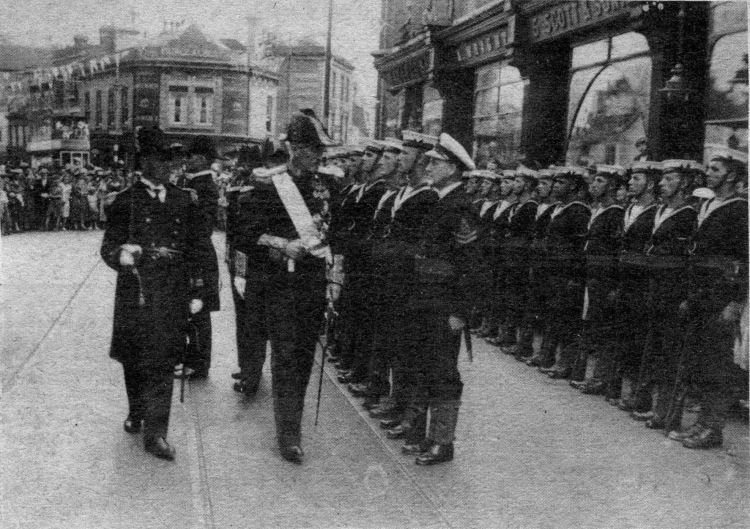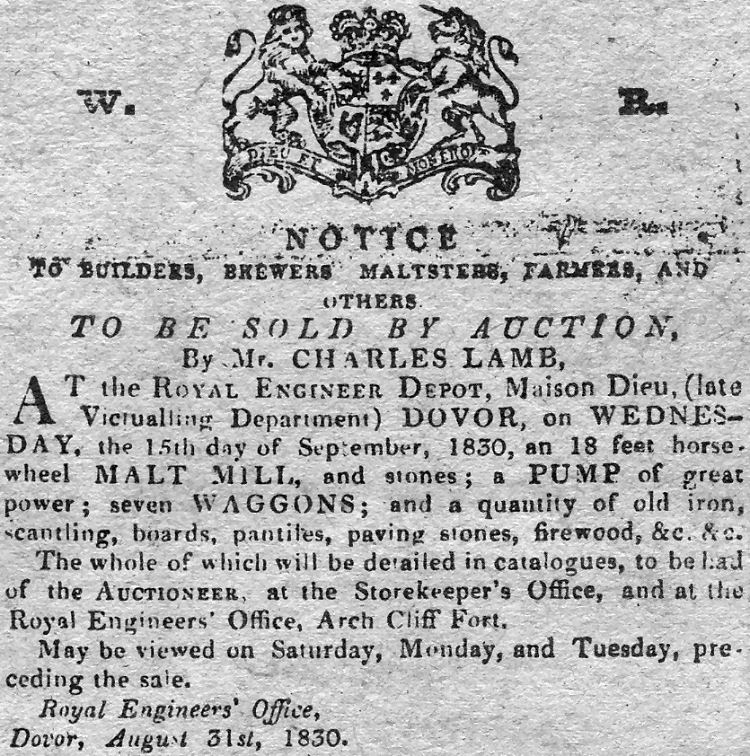Page Updated:- Sunday, 07 March, 2021. |
|||||
 Published in the Dover Express, 11 January, 1980. A PERAMBULATION OF THE TOWN, PORT AND FORTRESS. PART 49.
Dover Corporation history covers four periods:— (1) Saxon and Norman, when the exact form of government and the names of the Civic Chiefs are mostly unknown; (2) the Early English period, of which the records are more complete; (3) from the establishment of the Common Council, in 1558, until the Municipal Reform Act of 1835; and (4) the period of the Town Council, from 1835. Prom 1547 the sequence of the record is unbroken — a mayoral chain linking the reign of Edward VI with that of the reigning queen, covering a period of over 430 years. From an analysis of the list, it appears that during that period there have been over 310 different persons in the Civic Chair, the greater number of whom only held office one year. A considerable number served two or three years. The following mayors were in office four years: Thomas Pepper, Thomas Andrews, George Bynge, Nicholas Cullen, Sir Thomas Mantell, William Knocker, William Clarke, John Birmingham, Sir Richard Dickeson, R. J. Barwick and W. H. Fish. Five years were served by Stephen Monins, Henry Jelly, Thomas Bateman Lane and William Cocke, and six years by Edward Wivell and Sir Edwin Farley. Seven years were served by Captain William Stokes and James R. Cairns (1937-44); eight years by John Hollingberry. The distinction of having served as mayor the greatest number of times falls on Sir William Crundall, who, during a period of membership of the town council from 1883 until 1910, was elected mayor thirteen times. Only five of the mayors of Dover appear to have been knighted—Sir Thomas Teddiman, a Dover mariner, who rose to the rank of Admiral; Sir Thomas Mantell, agent for transports during the French war; Sir Richard Dickeson, Sir William Crundall, and Sir Edwin Wood Thorpe Farley, Dover businessmen. The list of town clerks is much shorter than that of the mayors. It contains thirty-eight names. The honour of having served the town for the longest period fell on Sir Wollaston Knocker, who held the office forty years. The office of Recorder has been filled by many eminent men. The list commences with the Stuart period, and among those who held office were Philip Yorke and Charles Yorke, who became Lord Chancellors, and three, William Henry Bodkin, Harry Bodkin Poland, K.C., and Archibald Henry Bodkin, K.C., were knighted. The Connaught Hall was built in 1882-83, on the site of the prison (erected at a cost of £9,300 in 1867), which was closed by the Prisons Act, 1878, owing to a diminution of crime. The women’s side was retained in use as a police station and lock-up.
THE POLICE FORCE The Dover Police Force, in the early days of its existence, had its station in Queen Street, later moving to the Maison Dieu where a prison was built. The duty of watch and ward, which was cast on the individual householders by the Dover charters and customal, was, in 1778, transferred to the Paving Commission, who were empowered to appoint armed watchmen, not exceeding twenty-four; and, in 1836, the present Police Force was instituted by the Town Council, under the provisions of the Municipal Corporations Reform Act. The first appointments were made by the newly constituted Watch Committee on the 18th of January, 1836, consisting of three Sergeants (W, Hopper, B. A. Obree and T. P. Back) and twelve Constables (R. Crosoer, W. Sutherden, E. Barton, J, Chandler, jun., W. Blunden, J. Crick, F, W. Gillispie, W, Smeed, G. Cole, T. Webber, A. Andrews and J. Beecham). They first went on duty on the night of Wednesday, 20th January, 1836. On the 8th of February following, Mr Henry Crosoer was appointed Inspector, that being the rank of the Chief Constable in the first instance. The watchmen under the Paving Commission had been sheltered in watch-boxes and watch-houses, but in 1838 the Corporation built a police station, with cells, in Queen Street, and that continued to be headquarters until a police station was opened at the Maison Dieu in the year 1881, after which Queen Street was retained as a fire station, the Dover police being also the fire brigade. The Police Force, as originally appointed, consisted of sixteen men, but in December, 1841, the town council decided to reduce the number to twelve, but they were increased from time to time, so that by 1934 there were 65. The first Superintendent of Police was Mr Correll, who succeeded Inspector Crosoer. Correll was called upon to resign in September, 1847, for having misappropriated supplies and altered the night reports. He was succeeded by Sergeant Laker, who had been in the Force since a few months after it was constituted, and he had been publicly presented with a testimonial for exemplary conduct. His appointment as Chief was made in October, 1847, He resigned in March, 1850, and was succeeded by Mr Rolf, who had been Chief of the Police in the Borough of Walsall. Mr Rolf resigned on August 15th, 1851, and was succeeded by Mr John Coram, who continued to hold the post of Superintendent until November, 1871, when he resigned. He was succeeded early in 1872 by Mr Thomas Osborn Sanders, a native of Wickhambreaux, Kent, who had been in the Metropolitan Force. He continued to hold the office until March, 1901—nearly 30 years—a long and honourable career. After his retirement, the town council appointed succeeding Chief Constables from officers in the Dover Police Force who had risen to be Inspectors. After Mr Sanders’ retirement, Dover’s Chief Constables were: 1901, Mr H. N. Knox Knott; 1908, Mr D. H. Fox; 1920, Mr C. Green; and in December, 1924, Mr A. M. Bond. The Force, in 1934, consisted of Mr Bond (the Chief Constable), three inspectors, nine sergeants and 52 constables. Control of the Force later passed to the Kent County Constabulary and that of the fire service to the Kent Fire Brigade.

A busy scene outside the Maison Dieu in 1936, the year the Marquis of
Willingdom was installed as Lord Warden of the Cinque Forts. After the
hallowing service at Dover Castle the Lord Warden, with the Marchioness of
Willingdon, drove in an open car in a procession of over a hundred vehicles
to Dover College for the installation ceremony. He then walked to the Town
Hall for the traditional luncheon given by the Cinque Ports and is pictured
inspecting a guard of honour formed up opposite the entrance by the Royal
Navy from Chatham, under the command of Lt-Commander J. V. W. Frizelle.
Halted outside the "Prince Albert" public house in the background was one of
the last trams to run in Dover. The Corporation Tramway system was abandoned
later that year. 
When the Maison Dieu ceased to be a victualling office for the Forces there was equipment to be disposed of and the Forces there was equipment to be disposed of and the above auction sale advertisement appeared in the Kentish Gazette of 7 September 1830.
|
|||||
|
If anyone should have any a better picture than any on this page, or think I should add one they have, please email me at the following address:-
|
|||||
| LAST PAGE |
|
MENU PAGE |
|
NEXT PAGE | |